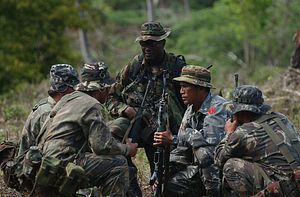The U.S. Department of Defense confirmed on Monday that it is actively considering the adoption of plans that would allow the U.S. military to carry out airstrikes on Islamic State-affiliated fighters in the southern Philippines, according to a report by NBC News.
Since late-May, the Armed Forces of the Philippines have been struggling to retake Marawi City on the southern Philippine island of Mindanao after it was overrun by militants affiliated with the Maute Group, which had declared its allegiance to the Islamic State’s caliphate.
U.S. military advisers have been operating in the Philippines since 2001 with a counterterrorism mission and have been active in assisting Filipino troops in the siege of Marawi City. The United States has additionally long shared intelligence with the Philippines as it fought against various armed groups in the south, ranging from the al-Qaeda-affiliated Abu Sayyaf to Communist and separatist rebels
The new plans would allow direct combat engagements for U.S. aerial assets — most likely unmanned combat aerial vehicles (UCAVs). The adoption of such a plan would be a boon to Philippine forces and mark a marked uptick in U.S. involvement in the ongoing fight against terror in Mindanao that has displaced thousands.
News of the new plans under consideration also come as U.S. Secretary of State Rex Tillerson is on his first trip to Southeast Asia. In Manila, on the sidelines of the 50th Association of Southeast Asian Nations (ASEAN) Ministerial Meeting (AMM), Tillerson met Philippine President Rodrigo Duterte, who took a markedly more positive tone with Tillerson than he had with officials from the previous U.S. administration.
Shortly after coming to office in 2016, Duterte became quickly known for his overt anti-American comments, which included threats to abrogate active defense cooperation agreements between the two allies. Though he did not move to take any steps to implement these threats, Duterte regularly threatened to evict all U.S. troops from the southern Philippines prior to the start of the ongoing campaign against the militants in Marawi City.
The adoption of any plans to deploy U.S. aerial assets would likely take place in consultation with the Philippines, a U.S. treaty ally. As Prashanth Parameswaran discussed in The Diplomat earlier this week, Duterte’s ongoing struggles in the campaign to retake Marawi City have led him to ask the Filipino legislature for additional troop funding.
More broadly, an escalation in U.S. involvement would serve to underline the ongoing inadequacy of the Armed Forces of the Philippines in managing intensifying domestic threats. Despite manifold challenges, ranging from armed groups in the southern parts of the country, transnational piracy, and maritime friction with China in the South China Sea, the Philippine military continues to be one of the weakest in Southeast Asia.
In the United States, the plan may encounter congressional resistance as concerns about presidential war powers under the 2001 Authorization for the Use of Military Force (AUMF) persist. In 2001, the Philippines was among the list of countries where the U.S. military deployed under the auspices of Operation Enduring Freedom. However, direct military operations may see additional congressional scrutiny.
Extended U.S. involvement in the ongoing conflict could also tie Duterte’s political fortunes more directly to the state of the relationship with the United States as the campaign to retake Marawi drags on. However, given the challenges of urban counterinsurgency, UCAV deployment by the United States is unlikely to be a decisive strategic development on the battlefield.
Instead, it could see the United States drawn into what could be just the start of a longer military quagmire in Southeast Asia.

































